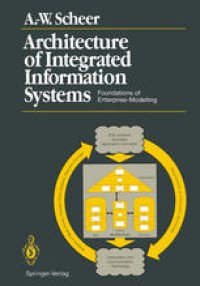
Ebook: Architecture of Integrated Information Systems: Foundations of Enterprise Modelling
- Tags: Business Information Systems, Production/Logistics/Supply Chain Management, Models and Principles, Information Systems Applications (incl. Internet)
- Year: 1992
- Publisher: Springer-Verlag Berlin Heidelberg
- Edition: 1
- Language: English
- pdf
The creation and implementation of integrated information systems involves a variety of collaborators including people from specialist departments. informatics. external advisers and manufacturers. They need clear rules and l1mits within which they can process their individual sub-tasks. in order to ensure the logical consistency of the entire project. An architecture therefore needs to be established to determine the components that make up the information system and the methods to be used to deSCribe it. Whereas previously. individual descriptive viewpoints such as the functional representation or the data model have dominated. this book creates an architecture within which the function. organization. and data views of an information system throughout the development phases of the requirements definition. design specification and the implementation deSCription can be given equal treatment. The ARIS architecture thereby developed is deSCribed in concrete terms as an information model within the entity-relationship approach. This information model provides the basis for the systematic and rational application of methods in the development of information systems. Furthermore. it is also the basis for a repository in which the enterprise's application-specific data. organization and function models can be stored. An essential property of the ARIS architecture is that the various views are not only considered in isolation. but a control view also represents their relationships with each other. As a result. new developments such as distributed databases or object-oriented approaches can be incorporated in the architecture. I would like to thank Irene Cameron for her careful translation of the German original.
The creation and implementation of integrated information systems involves a variety of collaborators including people from specialist departments, informatics, external advisers and manufacturers. They need clear rules and limits within which they can process their individual sub-tasks, in order to ensure the logical consistency of the entire project. Therefore, an architecture needs to be established to determine the components that make up the information system and the methods to be used to describe it. The ARIS architecture developed in this book is described in concrete terms as an information model within the entity-relationship approach. This information model provides the basis for the systematic and rational application of methods in the development of information systems. Furthermore, it serves as the basis for a repository in which the enterprise's application-specific data, organization and function models can be stored. The ARIS architecture constitutes a framework in which integrated applications systems can be developed, optimized and converted into EDP-technical implementations. At the same time, it demonstrates how business economics can examine and analyze information systems in order to translate their contents into EDP-suitable form.
The creation and implementation of integrated information systems involves a variety of collaborators including people from specialist departments, informatics, external advisers and manufacturers. They need clear rules and limits within which they can process their individual sub-tasks, in order to ensure the logical consistency of the entire project. Therefore, an architecture needs to be established to determine the components that make up the information system and the methods to be used to describe it. The ARIS architecture developed in this book is described in concrete terms as an information model within the entity-relationship approach. This information model provides the basis for the systematic and rational application of methods in the development of information systems. Furthermore, it serves as the basis for a repository in which the enterprise's application-specific data, organization and function models can be stored. The ARIS architecture constitutes a framework in which integrated applications systems can be developed, optimized and converted into EDP-technical implementations. At the same time, it demonstrates how business economics can examine and analyze information systems in order to translate their contents into EDP-suitable form.
Content:
Front Matter....Pages I-XIV
Conception of the ARIS Architecture for Integrated Information Systems....Pages 1-55
Development of the ARIS Information Model (Meta-Information System)....Pages 56-201
Back Matter....Pages 202-221
The creation and implementation of integrated information systems involves a variety of collaborators including people from specialist departments, informatics, external advisers and manufacturers. They need clear rules and limits within which they can process their individual sub-tasks, in order to ensure the logical consistency of the entire project. Therefore, an architecture needs to be established to determine the components that make up the information system and the methods to be used to describe it. The ARIS architecture developed in this book is described in concrete terms as an information model within the entity-relationship approach. This information model provides the basis for the systematic and rational application of methods in the development of information systems. Furthermore, it serves as the basis for a repository in which the enterprise's application-specific data, organization and function models can be stored. The ARIS architecture constitutes a framework in which integrated applications systems can be developed, optimized and converted into EDP-technical implementations. At the same time, it demonstrates how business economics can examine and analyze information systems in order to translate their contents into EDP-suitable form.
Content:
Front Matter....Pages I-XIV
Conception of the ARIS Architecture for Integrated Information Systems....Pages 1-55
Development of the ARIS Information Model (Meta-Information System)....Pages 56-201
Back Matter....Pages 202-221
....